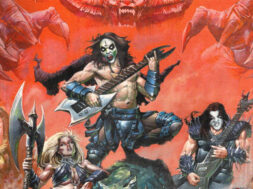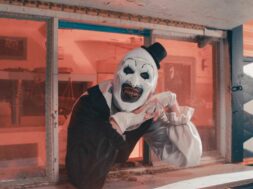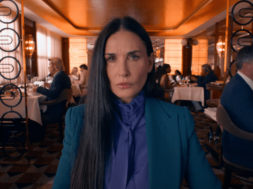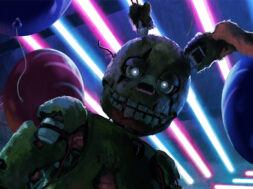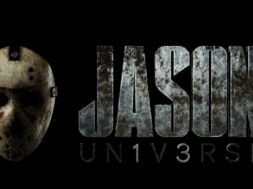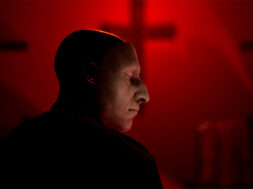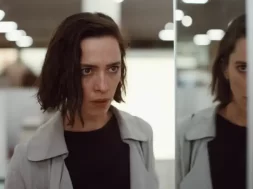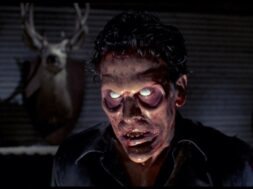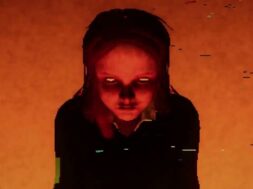The influence of horror in Rob Zombie‘s musical endeavors is unmistakable. From homages to German expressionism in Living Dead Girl to The Munsters references in Dragula (not to mention the band name White Zombie, itself borrowed from the homonymous 1933 classic), it was quite clear that the man was a spooky cinephile long before he directed his first film.
While Zombie’s movies eventually turned him into the cinematic equivalent of a rock star even among folks who don’t enjoy heavy metal (after all, he only became one of my favorite musicians after he was already one of my favorite filmmakers), little has been said about the influence that music had on the stories he decided to put on film, and I think that’s worth looking into. Zombie’s filmography has often been criticized for being repetitive, almost always relying on the same “Hellbilly” aesthetic that his solo career is known for, but at this point, I believe it’s more of a personal style than an artistic crutch (and I’m not the only one, with even Stephen King insinuating that Zombie did the faux-70s shtick better than Tarantino).
Born in 1965, Zombie’s infatuation with the strange and macabre began almost immediately. His parents worked at a carnival, and even after settling down in Massachusetts, young Rob would attempt to stave off boredom by consuming copious amounts of television. This led to an infatuation with late night monster movies, rock music and the cultural zeitgeist of the 1970s. Everything from New Hollywood to serial killers and our morbid fascination with their murderous exploits would eventually become inspiration for Zombie’s music.
It’s not surprising that these ideas would reoccur in his films, the first of which would be the infamous House of 1000 Corpses, released in 2003. The film shares a name with a song from 2001, and both deal with a creepy house inhabited by murderous members of a sadistic family. While it may initially seem that the movie is based on Zombie’s song, the film was actually completed in 2000, having been shelved for three years due to its questionable content. Zombie actually states that the idea for the story came to him after working on a Halloween attraction that would later be revised into The American Nightmare.
Rather than the film having inspired the song, however, it’s more than likely that both just share a common origin in Zombie’s lifelong fascination with these monstrous characters that inflict so much suffering on others but are still somehow so compelling. Fittingly enough, the original song actually features samples from Ilsa, She Wolf of the SS, and is also used in the film’s soundtrack, blending rather nicely with the movie’s score, also composed by Zombie. In fact, some scenes feel like prolonged music videos (which makes sense, considering how Zombie began his directing career with music videos), though the experimental editing wouldn’t look out of place in an actual 70s production.
At this point, it was clear that Zombie’s approach to filmmaking was similar to his approach to music. His work can be loud and crude, but he’s got something to say, and by God, he’s gonna make you see/hear it on his terms. Whether you like this style or not, it takes a lot of guts to make movies this way.
Zombie would later revisit the idea of a murderous family unit (almost certainly inspired by his interest in the Manson Family affair) in the long-awaited sequel, The Devil’s Rejects. Here, Zombie would continue his exploration of just how far these characters could go without making us hate them, and this sympathetic view of horrifying figures would become a recurring theme throughout nearly all of his work.
This film would also be accompanied by a homonymous single, though this one is much vaguer, literally dealing with deranged individuals deemed too evil even for hell. Nevertheless, the song doesn’t even play during the film (it’s not even featured on the soundtrack), as this movie’s influences are much closer to latter-day westerns and road movies than the slashers and monster flicks that inspired its prequel and much of Zombie’s musical work.
In general, The Devil’s Rejects’ soundtrack feels a lot like a love-letter to classic Americana, featuring heavy doses of Terry Reid, Joe Walsh and, of course, Lynyrd Skynyrd, in an attempt to match the Western-esque imagery. Naturally, the Freebird montage as the Firefly family faces the music (pun very much intended) is one of the film’s most memorable scenes, though it does spark a trend in Zombie’s filmography, as he’d develop a habit of ending his movies on an emotionally-charged moment accompanied by an iconic tune from the 70s.
That being said, a lot of people miss the fact that the movie means to question the celebration of the American Outlaw, and not necessarily contribute to it. Zombie’s attempts at humanizing Michael Myers in his Halloween remake and sequel seem to be an extension of this idea. Once again, these films don’t feature much of Zombie’s own tunes, instead continuing to rely on an oldies marathon, featuring classics like Nazareth’s Love Hurts and Alice Cooper’s Only Women Bleed, fitting in with the movie’s overall themes. Strangely enough, the same attention to detail doesn’t quite extend to John Carpenter’s musical cues, which frequently end up misused; and they’re almost entirely absent from the sequel.

Around the same time as Halloween II, Zombie also released The Haunted World of El Superbeasto, an animated adaptation of his comic-book series of the same name. Of course, the protagonist’s name was lifted from Zombie’s insanely popular single Superbeast, and the song’s music video also featured a robot remarkably similar to Murray, another character within the film. While this animated venture had a lukewarm reception, it also comes the closest to capturing the spirit of Zombie’s musical career. Featuring countless references to classic horror and a plethora of cameos, this Haunted World ends up feeling very much alive as a commemoration of rock and schlock. The movie also benefits from a hilarious soundtrack, though most of the original songs were written and performed by the comedy band Hard ‘n Phirm instead of Zombie.
We’d only see Zombie’s work on the big screen again in 2012, with the release of The Lords of Salem, a film that literally uses the eldritch power of music as a plot point. While the film’s name is derived from a 2006 track meant as a spiritual sequel to a previous single, American Witch, the connection between the film and song is mostly thematic, and the song once again isn’t featured on the film’s soundtrack.
Nevertheless, this is Zombie’s most serious exploration of music in film so far, with the story revolving around a DJ that becomes involved in a Satanic conspiracy after playing a cursed record. Lords of Salem is a surprising shift in tone when compared to Zombie’s previous work, and the unique soundtrack reflects this as well. Not only was the eerie score composed by Rob’s guitarist John 5, but the film also features heavy usage of The Velvet Underground & Nico’s hauntingly beautiful All Tomorrow’s Parties.
As a whole, Lords of Salem even resembles an ambient album in its structure and atmosphere, which might be why it’s a love-it-or-hate-it kind of movie. Even so, Zombie’s next film would be even more divisive, feeling like a best-of compilation, rehashing some of the director’s greatest hits instead of presenting us with something new. After a few years digesting the film, I actually enjoy 31 a lot more now, but it still pales in comparison to the director’s previous work.
The 70’s grindhouse aesthetic is still fun, if expected by now, and so is the accompanying jukebox soundtrack. The highlight of the film, however, lies in the ending, which, ironically, features both the best and worst of Zombie’s filmmaking talents and vices. Aerosmith’s Dream On builds to a crescendo just as you thought the coast was clear on deserted road, and then spoilers ensue. I’m still not sure if the rest of the film deserves such a powerful final scene, but I’m glad it’s there, as it reminds us that even Zombie’s lesser attempts at storytelling still have merit.
With that in mind (not to mention Three From Hell looming on the horizon), I’m excited to see (and hear) what Rob Zombie has in store for us during the next stage of his heavy metal filmmaking career. In the past, he’s said that he hopes that every one of his films features at least one song that you can never hear the same way again after experiencing it in the movie, and I think it’s safe to say that, for better or worse, he’s kept that promise so far.
